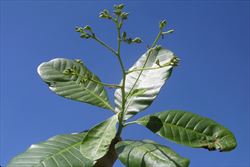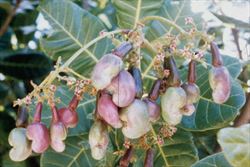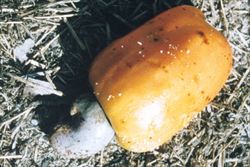Click on images to enlarge

leaves and flower buds (Photo: Chris Gardiner)

leaves and flower buds (Photo: Chris Gardiner)

immature fruit (Photo: Chris Gardiner)

mature fruit with cashew nut (Photo: Chris Gardiner)
Scientific Name
Anacardium occidentale L.
Family
Anacardiaceae
Common Names
cashew, cashew apple, cashew nut, cashew nut tree, cashew tree
Origin
Native to tropical South America (i.e. French Guiana, Guyana, Surinam, Venezuela, Brazil, Peru and Colombia).
Naturalised Distribution
This species is becoming widely naturalised in the wetter parts of northern Australia (i.e. in northern Queensland and the coastal districts of the Northern Territory). Possibly also naturalised in the coastal districts of northern Western Australia.
Also naturalised in southern Africa (i.e. South Africa and Mozambique), the Caribbean (i.e. Jamaica, Puerto Rico and the Virgin Islands), south-eastern Asia (i.e. Cambodia) and on some Pacific islands (e.g. the Cook Islands and Niue).
Notes
Cashew nut (Anacardium occidentale) is an emerging environmental weed in the Northern Territory and northern Queensland, and is regarded as a potential environmental weed or "sleeper weed" in other parts of northern Australia. It is cultivated in tropical regions for its edible fruit, but has been spread by fruit bats and other animals into natural vegetaiton. While it currently has a relatively limited distribution and impact, this species is thought to have the potential to become a serious weed in the monsoon regions of Australia.
Cashew nut (Anacardium occidentale ) was first recorded as naturalised in the Northern Territory in 1988, though it is thought to have been present for some time prior to this. It grows on the edges of monsoon forests near Darwin and is regarded as a problem weed in the Tiwi-Cobourg bioregion, being particularly widespread on Melville Island.
In Queensland, cashew nut (Anacardium occidentale) is a weed on the Cape York Peninsula and is becoming invasive on Horn Island in the Torres Strait. It is also listed as an undesirable plant in Townsville City and Thuringowa City because of its current or potential adverse impact on natural vegetation in the Townsville region.
There are also unconfirmed reports that cashew nut (Anacardium occidentale) is naturalised in the coastal areas of Western Australia north of Broome, and that it is common around settlements in the Kimberley region.

